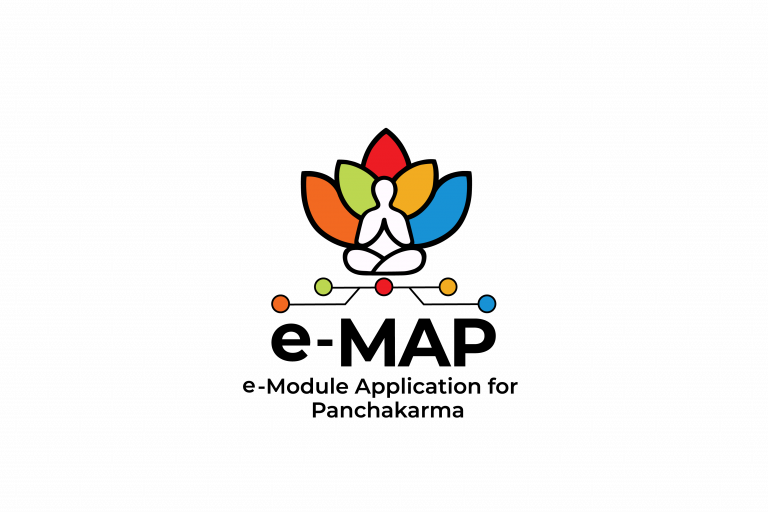
PG Module 5
VIRECHANA KARMA

EXPLANATORY NOTES
त्र्यहावरं सप्तदिनं परं तु स्निग्धो नरः स्वेदयितव्य उक्तः ||
नातः परं स्नेहनमादिशन्ति सात्म्यीभवेत् सप्तदिनात् परं तु| (Cha. Si. 1/6-7)
Snehanahas to administered for minimum of three days and a maximum of seven days. If administered even after seven days the person’s body gets sātmya to it.
मृदुकोष्ठस्त्रिरात्रेण स्निह्यत्यच्छोपसेवया|
स्निह्यति क्रूरक्रोष्ठस्तु सप्तरात्रेण मानवः|| (Cha. Su. 16/65)
It has been explained for mṛdukoṣṭha three days of snehapāna, and for krūrakoṣṭha maximum of seven days of snehapāna. Within these stipulated days the samyaksnigdhalakṣaṇas are observed.
Śodhanāṅgasnehapāna and sadyosnehapāna also can be opted as a pūrvakarma before śodhana.
मांसला मेदुरा भूरिश्लेष्माणो विषमाग्नयः||
स्नेहोचिताश्च ये स्नेह्यास्तान् पूर्वं रूक्षयेत्ततः|
संस्नेह्य शोधयेदेवं स्नेहव्यापन्न जायते|| (A. H. Su. 16/36)
In persons having māṃsalā, medura, bahu kapha, viṣamāgni and snehasātmya, before abhyantarasnehapāna, rūkṣana has to be done to prevent snehavyāpat
मन्दाग्निंक्रूरकोष्ठंचसक्षारलवणैर्घृतैः||
सन्धुक्षिताग्निंविजितकफवातंचशोधयेत्| (A. H. Su. 18/52)
Those who are having weak digestive power and costive bowels (krūrakoṣṭha) should be given ghee processed with alkalies and salts prior to the administration of purificatory drugs to restore the power of digestion as well as to conquer kapha and vāta.
विषाभिघातपिटिकाकुष्ठशोफविसर्पिणः|
कामलापाण्डुमेहार्तान्नातिस्निग्धान्विशोधयेत्||
सर्वान्स्नेहविरेकैश्च, रूक्षैस्तुस्नेहभावितान्| (A.H. Su. 18/56)
For diseases like viṣa, abhighāta, piḍakā, kuṣṭha, śopha, visarpa, kāmala, pāṇḍu, and meha, virecana should be given without undergoing too much prior snehana. In rūkṣa conditions, snehavirecana can be administered. Patients who are atisnigdha, for them rūkṣavirecana is given.
All the above should be given snigdhavirecana and those who are unctuous should be given rūkṣavirecana
स्नेहनं स्नेहविष्यन्दमार्दवक्लेदकारकम् | (Cha. Su. 22/11)
Snehana is a procedure which enhances snigdhatā to the śarīra, by causing viṣyandana of doṣas and does the mārdavata and kledata to the śarīra.
स्नेहोऽनिलं हन्ति मृदूकरोति देहं मलानां विनिहन्ति सङ्गम्|| (Cha. Si. 1/7)
By the snehana therapy, as it is having the opposite guṇa of vāta, it helps the proper gati of vāta, and expels the saṅghātadoṣas and does the dehamṛdutā
वृद्ध्या विष्यन्दनात् पाकात् स्रोतोमुखविशोधनात्|
शाखा मुक्त्वा मलाः कोष्ठं यान्ति वायोश्च निग्रहात्|| (Cha. Su. 28/33)
By vridhi, viṣyandana, pāka, srotomukhaviśodhana and vayoschanigraha. These processes are carried out by snehana (snehapāna and bāhya Sneha) and svedana. The śākhā gatadoṣas are brought back to koṣṭha, and they are easily expelled out through the prescribed
DIET
द्रवोष्णमनभिष्यन्दि भोज्यमन्नं प्रमाणतः|
नातिस्निग्धमसङ्कीर्णं श्वः स्नेहं पातुमिच्छता|| (Cha. Su. 13/60)
Intake of Drava, uṣṇa, anabhiṣyandi, not atisnigdha and asaṅkīrṇaāhāra and pānahas to be administered.
स्निग्धद्रवोष्णधन्वोत्थरसभुक्स्वेदमाचरेत्|
स्निग्धस्त्र्यहंस्थितःकुर्याद्विरेक (A. H. Su. 16/36)
During the three days gap prior to virecana, sarvāṅgaabhyaṅga and svedana should be done. The diet advised during these days should be snigdha, drava, uṣṇa, jaṅgalamāṃsa rasa.
After Abhyaṅga and svedana, peyā should be administered on the previous day of virecana.
Before virechana, the diet administered should be drava, laghu, and ashitaāhārapāna
रसैस्तथा जाङ्गलजैः सयूषैः स्निग्धैः कफावृद्धिकरैर्विरेच्यः| (Cha. Si. 1/9)
The person who is to be given purgation therapy should be given jaṅgalamāṃsa rasa, snigdhayūṣa, and food which do not produce kaphavṛddhi.
स्निग्धस्विन्नो विरेच्यस्तु पेयामात्रोषितः सुखम्| (Cha. Ka. 7/12)
After Abhyaṅga and svedana, peya should be administered on the previous day of virecana.
सुजरं द्रवभूयिष्ठं, लघ्वशीतं विरेचनम्|| (Cha. Si. 6/12)
Before virechana, the diet administered should be drava, laghu, and ashitaāhārapāna.
अथातुरं श्वो विरेचनं पाययिताऽस्मीति पूर्वाह्णे लघु भोजयेत्, फलाम्लमुष्णोदकं चैनमनुपाययेत् | (Su. Chi. 33/20)
Whereas Suśrutaācārya mentions laghubhojana, amla phala rasa along with uṣṇajalahas to be administered as it will alleviates the pitta doṣa and will help in kaphaavajayārtha.
स्नेहमग्रे प्रयुञ्जीत ततः स्वेदमनन्तरम्|
स्नेहस्वेदोपपन्नस्य संशोधनमथेतरत् || (Cha. Su. 13/99)
Snehana and svedana procedures are said to be the prime preoperative procedures to be administered before śodhana. As these imparts the proper movement of the aggravated doṣas from śākha to koṣṭha. This is achieved only by these procedures.
स्निग्धः स्वेदैरुपक्रम्यः स्विन्नः पथ्याशनो भवेत्|
तदहः स्विन्नगात्रस्तु व्यायामं वर्जयेन्नरः (Cha. Su. 14/67)
During the bāhyasnehana and svedanaupakramas,anabhiṣyandiāhāra should be consumed. In addition to the said pathyās, śanaiḥ śanaiḥ mardana, uṣṇajalasnāna covering the body with blankets and staying in nivātasthāna etc. are explained in pathyavihāras as these helps in controlling the vāta. During svedana, vyāyāma should be avoided.
स्नेहस्वेदावनभ्यस्य यस्तु संशोधनं पिबेत् |
दारु शुष्कमिवानामे देहस्तस्य विशीर्यते || (Su. Chi 33/46)
ĀcāryaSuśruta says that, without proper pūrvakarmas like snehana and svedana the samśodhanaauṣadhi and the hazardous afflictions produced by the procedure can destroy the body easily like the dried wood.
मलो हि देहादुत्क्लेश्य ह्रियते वाससो यथा||
स्नेहस्वेदैस्तथोत्क्लिष्टः शोध्यते शोधनैर्मलः| (A. H. Su.18/58)
AcāryaVāgbhaṭa says thatDuringśodhana the doṣas are removed from the body by snehana and swedana in the same way as dirt in the cloth is removed with the help of soap and hot water.
स्नेहनैर्व्याधितस्थानाद्रसैश्चाभ्यधिकीकृता।
स्वेदैर्मृदुकृतास्सन्तःस्रोतसाचसमागता॥
मृदुसर्वाङ्गकोष्ठस्यभेषजैश्शुचिभिस्तदा।
दोषास्सुनिर्हराजन्तोर्वमन्तीतिविनिश्चयः॥ (Bhela Samhita)
It is very certain that in a person all the morbidities become easily removable, when these are displaced by unction, made augmented by assimilable essence of the food, rendered softened by sudation and thus reached from everywhere to the channels and made cleansed up by medicines.
स्नेहक्लिन्नाःकोष्ठगाधातुगावास्रोतोलीनायेचशाखास्थिसंस्थाः।
दोषाःस्वेदैस्तेद्रवीकृत्यकोष्ठंनीताःसम्यक्शुद्धिभिर्निर्ह्रियन्ते॥२९॥ (A. H. Su. 17/30)
Doṣas which are lodged at koṣṭha, dhātus, śākhās, asthi, and līnadoṣas in srotases, which are the causative factors of diseases, when snehana procedures are administered, these doṣas are formed to a klinnaavasthā. And by swedana procedures, they are undergone dravīkaraṇa and brought to koṣṭha. And finally expelled out through proper śodhana procedures.
अथैनं पुनरेव स्नेहस्वेदाभ्यामुपपाद्यानुपहतमनसमभिसमीक्ष्य सुखोषितं सुप्रजीर्णभक्तं कृतहोमबलिमङ्गलजपप्रायश्चित्तमिष्टे तिथिनक्षत्रकरणमुहूर्ते ब्राह्मणान् स्वस्ति वाचयित्वा || (Cha.su.15/17)
After undergoing sarvāṅgaabhyaṅga and bāṣpasweda, the patient should be assessed whether the food taken in the previous night has been digested properly, whether the patient had a sound sleep in the previous night, and should offer prayers, and oblations. The brāhmaṇas should be invited to recite the auspicious svastivācanas, and on an auspicious, tithinakṣatra, karaṇa and muhūrta.



